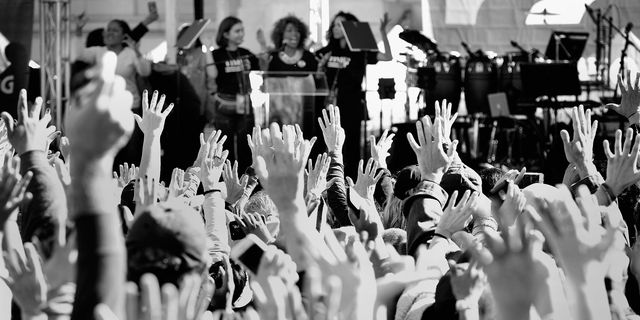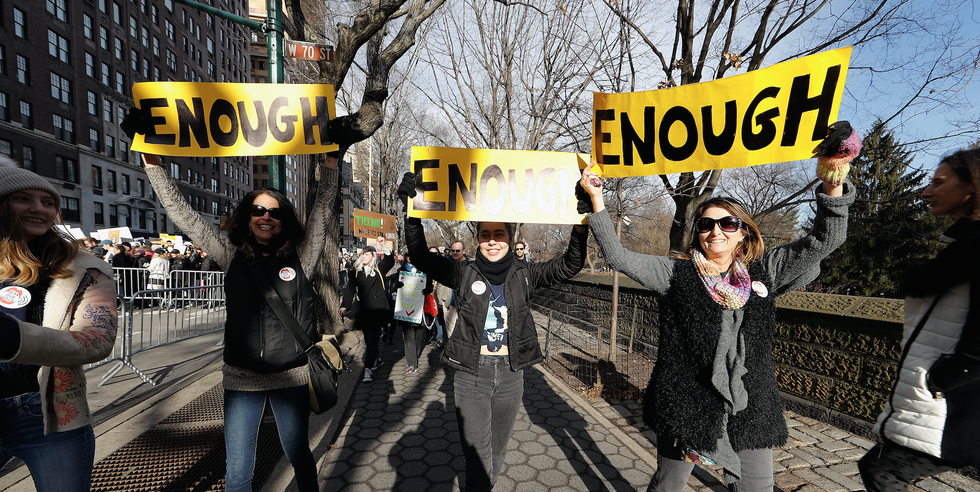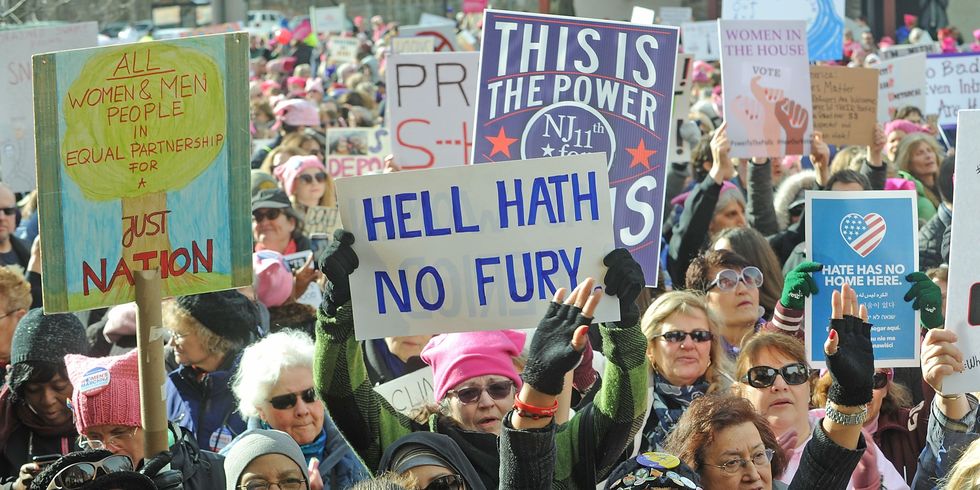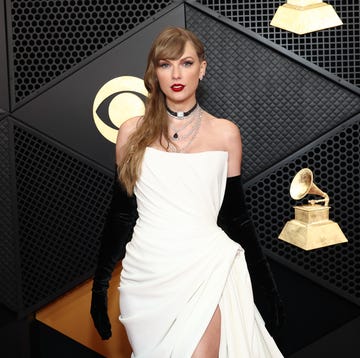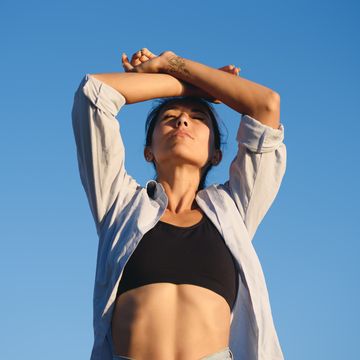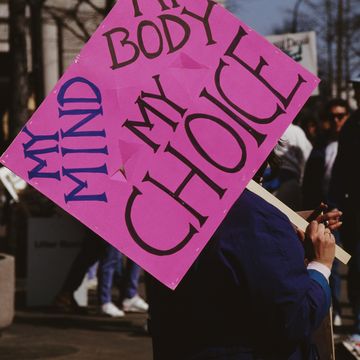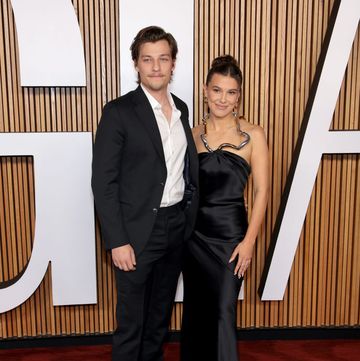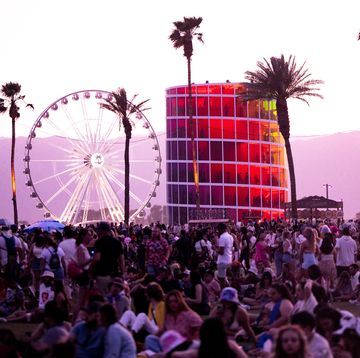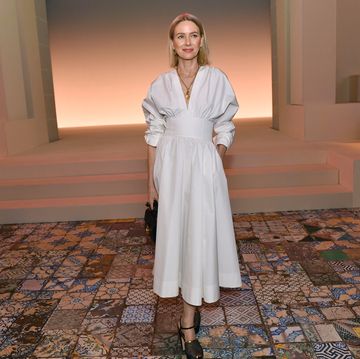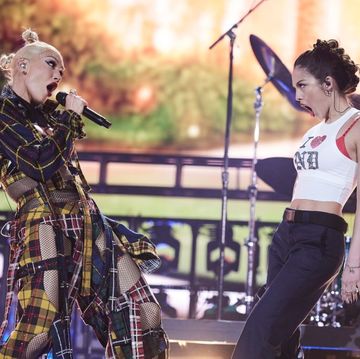Over one million people participated in women's marches around the world this weekend. But blink, and you'll miss all the attention paid to them on Sunday's top five political talk shows. It amounted to about seven seconds.
As Media Matters reported, the shows, which include ABC's This Week, CBS' Face the Nation, CNN's State of the Union, Fox's Fox News Sunday, and NBC's Meet the Press, "were nearly silent on the topic." In the midst of a government shutdown, which lasted under 72 hours, the bookers roped in over a dozen lawmakers and government officials to speak to that crisis instead.
Insult! Meet injury. None were women.
Out of all the shows, the marches were treated to the most comprehensive coverage on This Week, which mentioned them twice. First, when host George Stephanopolous included a line on "the Women's Marches in hundreds of cities all across the country" at the top of program. Second, when panelist Karen Finney later noted "all the people who were marching in the streets [on Saturday]." Thank you, Karen.
"These shows often set the tone and priorities for media coverage for the rest of the week," Media Matters continued in its assessment, and it must be true because outside of Instagram, where friends have continued to share ecstatic selfies from Columbus Circle and downtown L.A., I've found too little examination of the marches in the mainstream press. And I mean examination—not summaries. Because sure, the Atlantic posted photos from the demonstrations, the New York Times recapped the events, and Vox visualized incredible data on what it termed the "sustained protest movement against the Trump administration" that's developed over the past 12 months.
But that's no substitute for the real work of journalism—to parse social movements and trends, to put them in context, and to establish the wider landscape in which they participate. (How exactly do you think we ever came to learn so much about the Tea Party?) If Trump fans, who represent a sliver of the electorate so small that Trump remains the most unpopular president since Harry Truman, are given the full run of the New York Times editorial section because we need to better understand them, then surely the greatest mass mobilization of women nationwide (ever?) deserves at least an equivalent measure of attention.
Or at least, I think so.
But alas, the news doesn't seem to. Instead, it looks like someone decided that stories about the movement and who powers it are "niche," only of interest to women and those who read the publications that are aimed at us. And while we've gotten stories about women who've decided to run for office since the first Women's March in the mainstream media, and many are excellent, better still would be stories of the black women who elected Sen. Doug Jones in Alabama and Gov. Ralph Northam in Virginia. How politically active were they until now? When did they realize they needed to band together? How'd they do it? Why?
"These stories are out there, but people of color, black folks, brown folks, women are underrepresented in the political world," Symone D. Sanders, a frequent commentator on CNN and political strategist, tells me in a phone interview. "And that's true in the press, too. So whose stories do we decide to highlight? What profiles do we decide to write?" And lest we naively believe that narratives in the media aren't determinative, let's remember how some of the same men who shaped the public perception of Hillary Clinton (the ones who called her shrill and said that she screamed and couldn't let go of her emails, even as the Russians hacked the election under our noses) were just a few months ago revealed to be sexual harassers, abusers, and incessant predators.
"The treatment of the first woman to ever win the nomination on a major party ticket was colored through the lens and views of these men," Sanders says. "That's something that we can't ignore. So I think about the folks who write these stories, like, 'Oh, you can't march twice,' or, 'Oh, well where is the proof of the real work?' And I have to think that some of them don't believe in the power of women or refuse to see the wins that have been achieved because of them."
So how then to cover what one smart man has called "the most underestimated, unappreciated, and underreported political movement" since the dawn of the Republic? A few ideas!
How about exhaustive, endless accounts of what keeps these women up at night, what puts them off the status quo and "business as usual" politics. Stories that give the same concern to the circumstances of women in Ohio and Alabama and New York as they do to those of coal miners in West Virginia. What will these women demand from their representatives? What will they refuse to tolerate? What litmus tests will they impose on their candidates? Give me the stories that were given to the towns where it's never not Christmas and to the Ohio Nazi who registers for muffin pans at Target.
I guess what I mean is please choose to believe that women are just as fed up as all the irate white men the media loves to cover and that they should make headlines, too.
On social media, Sanders continues, women can do much of that work themselves, "elevating their own voices and telling their own stories." But it's not just the lack of apparent interest from mainstream news sources in this movement that infuriates her. It's the media's apparent condescension toward it, an attitude that wonders aloud just how much these women will in fact accomplish.
"They did vote! They do vote! They will vote," Sanders insists. She cites the races in Alabama and Virginia, the 30 or so seats that flipped from red to blue in 2017, all wins already powered by women and by black women, in particular. "When people write these stories, I would venture that they're uninformed and not truly paying attention."
Dana Fisher, a social scientist at the University of Maryland who will soon finish a book on the resistance under Trump, adds that while the lack of press has disappointed her, her research suggests it will just further galvanize women to protest, speak out, and organize. "The more underestimated people are, first, the more pissed off they get, but second, the more determined they are to show what they can do."
So with or without the outlets, advocates intend keep up their efforts and their focus on what matters: the ballot. "Women are marching in the streets by the millions because we reject pervasive misogyny, attacks on reproductive rights—including abortion access—and a culture where #MeToo moments feel far too familiar to all of us," wrote NARAL National Communications Director Kaylie Hanson Long in an emailed statement. "It's time to recognize us not as just a sea of pink hats, but as a driving force for political change."
And the data we have backs that up. A Washington Post/ABC News poll released on Monday found that the Democrats have a leg up in the 2018 congressional races, thanks in no small measure to "strong support from women," who've given them "a 57 percent to 31 percent advantage." Almost 80 women have indicated an interest in gubernatorial races. 26,000 women have reached out to EMILY's List to learn more about how to run for office.
If three's a crowd, what's millions of women? Journalists! Talk show hosts! Everyone but the Twitter trolls. Let's go find out.
